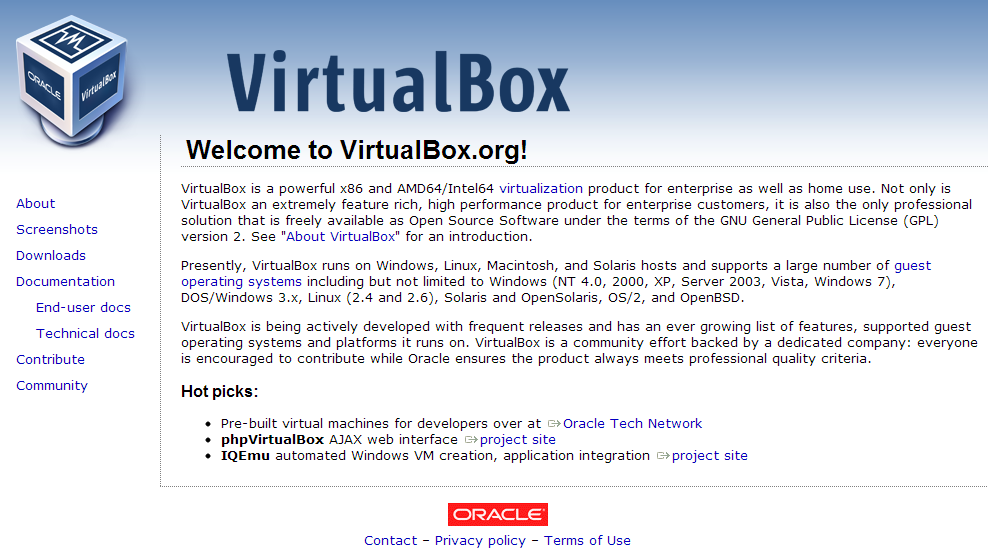| เราพยายามที่จะ จำกัด วงเว็บไซต์ของเราในภาษามากที่สุดเท่าที่เป็นไปได้ แต่หน้านี้ในปัจจุบันคือเครื่องแปลโดยใช้ Google แปล | ใกล้ |
-
-
ผลิตภัณฑ์
-
แหล่งที่มา
-
สนับสนุน
-
บริษัท
-
เรียกใช้รุ่นของ Windows ก็ใช้ VirtualBoxRun Another Version of Windows Using VirtualBox
โดย Steve Horton มีนาคม 14, 2013virtualbox, Windows 7, Windows XP1 ความคิดเห็นมีหลายกรณีที่คุณต้องการเรียกใช้ระบบปฏิบัติการ Windows ที่แตกต่างกันภายในระบบที่คุณมีอยู่แล้ว บางทีแอปพลิเคชันหรือไดรเวอร์อาจไม่ทำงานใน Windows ที่คุณมี หรือมีปัญหาความเข้ากันได้ หรือบางทีคุณต้องการทดสอบบางอย่างใน Windows โดยไม่ต้องทำการติดตั้งแบบสมบูรณ์ นั่นคือสิ่งที่ VirtualBox เข้ามา หาได้จากเว็บไซต์ของพวกเขา

คลิกดาวน์โหลดในแถบด้านข้างสำหรับผู้เริ่มต้นเครื่องเสมือนเป็นเพียงโปรแกรมที่ใช้ระบบปฏิบัติการภายในระบบปฏิบัติการอื่น – และในกรณีนี้คุณกำลังพยายามทำสิ่งนั้นอย่างแน่นอน ตัวเลือกอื่น ๆ เช่นการบูทคู่ – ซึ่งคุณเลือกระบบปฏิบัติการที่จะบูทเมื่อคุณเปิดเครื่องคอมพิวเตอร์ บางคนชอบความสะดวกสบายและความสะดวกในการใช้งานเครื่องเสมือนจริงมากกว่าในระบบปฏิบัติการที่มีอยู่แล้ว เหตุผลในการใช้เครื่องเสมือนไม่สามารถใช้ฟังก์ชั่นที่ต้องการในระบบปฏิบัติการที่มีอยู่ของคุณ – ตัวอย่างเช่นผู้ใช้ Mac มักจะเห็นการใช้งาน Windows ในเครื่องเสมือนและในทางกลับกัน – และการจำลองเสมือนก็เป็นเทคโนโลยีใหม่ ใช้ที่ธุรกิจโรงเรียนและศูนย์ข้อมูล
หากคุณต้องติดต่อผู้ให้บริการสนับสนุนด้านไอทีคุณจะรู้ว่า Virtual Machines นั้นเป็นที่นิยมมากที่สุดในหมู่ผู้ใช้ Mac และ Linux แม้ว่าจะมีเจ้าของ Windows จำนวนมากที่ใช้งานมันเช่นกัน สำหรับเราเป็นการส่วนตัวเราได้รับการตอบสนองที่ยอดเยี่ยมและแก้ไขปัญหาจาก Netzen ซึ่งเป็นหนึ่งในผู้ให้บริการสนับสนุนด้านไอทีชั้นนำในสหราชอาณาจักรที่มีสำนักงานในรีดดิ้ง เมดเดนเฮดและสลาวห์ ฉันขอแนะนำให้คุณลองดูที่ สหราชอาณาจักร
ข้อกำหนด VirtualBox
หากต้องการเรียกใช้ Windows รุ่นอื่นโดยใช้ VirtualBox ให้ใช้โปรแกรม OS บนดิสก์ด้วยตัวเองและใช้เวลาเพียงเล็กน้อย ก่อนอื่นโปรเซสเซอร์ของคุณรองรับระบบเสมือนจริงหรือไม่ หากเป็นเช่นนั้นก็อาจไม่ได้เปิดไว้ตามค่าเริ่มต้น เข้าสู่ BIOS และเปิดใช้งานการจำลองเสมือน หากคุณไม่เห็นตัวเลือกใน BIOS ของคุณคุณอาจไม่สามารถเรียกใช้เครื่องเสมือนได้ เมื่อคุณกลับสู่เดสก์ท็อปปกติให้เปิด VirtualBox
ตอนนี้เราสามารถเริ่มต้นได้จริงๆ
คำแนะนำ VirtualBox
ใน VirtualBox คลิก ใหม่ ตั้งชื่อระบบปฏิบัติการตามที่คุณต้องการ แต่เลือก Microsoft Windows สำหรับระบบปฏิบัติการและเลือกรุ่นของ Windows ที่คุณกำลังใช้งานในเมนู Version

สิ่งที่คุณจะเลือกหากคุณกำลังใช้งาน Windows 7หลังจากนี้คุณจะต้องกำหนดจำนวนหน่วยความจำที่คุณจะจัดสรรให้กับระบบปฏิบัติการจำลอง กฎทั่วไปคือใช้ RAM ครึ่งหนึ่ง – ดังนั้นถ้าคุณมี RAM 2 GB ให้ใช้ 1 GB ถ้าคุณมี 4 ใช้ 2 และอื่น ๆ เมื่อคุณตั้งค่าการจัดสรรชื่อและหน่วยความจำแล้วให้ไปยังขั้นตอนถัดไป
คุณจะต้องตั้งค่าฮาร์ดไดรฟ์เสมือนจริงสำหรับเครื่องเสมือนเพื่อใช้งาน มีอย่างน้อย 50 GB ในการพิจารณาว่าระบบปฏิบัติการมีขนาดใหญ่เพียงใดและให้แน่ใจว่าคุณมีพื้นที่มากพอสำหรับโปรแกรมที่คุณกำลังใช้งานและไฟล์ที่คุณกำลังใช้ ติดขนาดคงที่เพื่อความมั่นคง เมื่อคุณตัดสินใจแล้วว่าฮาร์ดไดรฟ์เสมือนควรมีขนาดใหญ่เท่าใดให้ไปยังขั้นตอนต่อไป
ต้องใช้เวลานานพอสมควรในการสร้างไดรฟ์เสมือน ในขณะที่รอรับแผ่นดิสก์การติดตั้งและจดหมายเลขการยืนยันที่คุณต้องการ เมื่อคุณรวบรวมทุกสิ่งที่คุณจะต้องใช้ในการตั้งค่าการติดตั้ง Windows ใหม่ของคุณเพียงแค่รอให้ฮาร์ดไดรฟ์เสมือนเสร็จสิ้น อาจใช้เวลาตั้งแต่ครึ่งชั่วโมงถึงหนึ่งชั่วโมงหรือนานกว่านั้นขึ้นอยู่กับว่าคุณตัดสินใจให้มันใหญ่แค่ไหน
ตอนนี้คุณจะต้องไปที่การตั้งค่า เพื่อให้แน่ใจถึงความเข้ากันได้เลือก เปิดใช้งาน IO APIC ในแท็บแผงวงจรหลัก ในแท็บโปรเซสเซอร์ให้เลือก Enable PAE / NX และในแท็บการเร่งความเร็วให้เลือกทั้งสองตัวเลือก
หลังจากที่คุณทำทั้งหมด – ขอแสดงความยินดีคุณทำเสร็จแล้ว สร้างเครื่องเสมือนของคุณแล้ว วางแผ่นดิสก์ระบบปฏิบัติการที่คุณตั้งใจจะทำเวอร์ชวลไลซ์ไว้ภายในคอมพิวเตอร์ของคุณเรียกใช้เครื่องเสมือนและเลือกดิสก์ไดรฟ์ โปรดทราบว่าหากคุณมีไฟล์อิมเมจดิสก์. ISO อย่างเป็นทางการของระบบปฏิบัติการ Windows คุณสามารถใช้ไฟล์นั้นได้เช่นกัน
เมื่อคุณทำสิ่งนั้นเสร็จแล้วให้ตั้งค่าระบบปฏิบัติการเสมือนใหม่ตามปกติ เนื่องจาก VirtualBox ใช้ระบบปฏิบัติการอื่นระบบปฏิบัติการเสมือนจริงจึงคาดว่าจะสามารถควบคุมเมาส์และคีย์บอร์ดของคุณได้ตลอดเวลา การคลิกหน้าต่างที่เปิดอยู่จะเป็นการควบคุมระบบปฏิบัติการของเมาส์และคีย์บอร์ดของคุณ แต่หากต้องการออกไปให้กด CTRL อย่างไรก็ตามคุณสามารถเปลี่ยนเป็นคีย์อื่นในการตั้งค่า ที่ด้านล่างของหน้าต่าง VirtualBox ของคุณจะแสดงปุ่มที่จะกดเพื่อออกจากมันเสมอเพื่อเตือนความจำ
สิ่งที่ดีเกี่ยวกับระบบปฏิบัติการเสมือนคือถ้ามันล้มเหลวเพียงแค่รีสตาร์ทเครื่อง มันจะไม่นำพีซีทั้งหมดของคุณไปด้วย โชคดี!
Was this post helpful?YesNoฟรี อัพเดตไดร์เวอร์
อัปเดตไดรเวอร์ของคุณในเวลาน้อยกว่า 2 นาทีเพื่อความสนุกที่ดีขึ้น ประสิทธิภาพของพีซี - ฟรี.
ฟรี อัพเดตไดร์เวอร์
อัปเดตไดรเวอร์ของคุณในเวลาน้อยกว่า 2 นาทีเพื่อความสนุกที่ดีขึ้น
ประสิทธิภาพของพีซี - ฟรี.
ไม่พบคำตอบของคุณหรือไม่ถามคำถามต่อชุมชนของเราของผู้เชี่ยวชาญจากทั่วโลกและได้รับการตอบในเวลาที่ทุกคนmost relevant บทความที่ผ่านมา ปักหมุดบน Pinterest